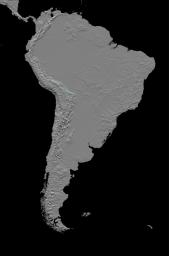This anaglyph (stereoscopic view) of South America was generated with data from the Shuttle Radar Topography Mission (SRTM). It is best viewed at or near full resolution with anaglyph glasses. For this broad view the resolution of the data was first reduced to 30 arcseconds (about 928 meters north-south but variable east-west), matching the best previously existing global digital topographic data set called GTOPO30. The data were then resampled to a Mercator projection with approximately square pixels (about one kilometer, or 0.6 miles, on each side). Even at this decreased resolution the variety of landforms comprising the South American continent is readily apparent.
Topographic relief in South America is dominated by the Andes Mountains, which extend all along the Pacific Coast. These mountains are created primarily by the convergence of the Nazca and South American tectonic plates. The Nazca Plate, which underlies the eastern Pacific Ocean, slides under western South America resulting in crustal thickening, uplift, and volcanism. Another zone of plate convergence occurs along the northwestern coast of South America where the Caribbean Plate also slides under the South American Plate and forms the northeastern extension of the Andes Mountains.
East of the Andes, much of northern South America drains into the Amazon River, the world's largest river in terms of both watershed area and flow volume. Topographic relief is very low in much of the Amazon Basin but SRTM data provide an excellent detailed look at the basin's three-dimensional drainage pattern, including the geologic structural trough (syncline) that hosts the eastern river channel.
North of the Amazon, the Guiana Highlands commonly stand in sharp contrast to the surrounding lowlands, indeed hosting the world's tallest waterfall, Angel Falls (979 meters or 3212 feet). Folded and fractured bedrock structures are distinctive in the topographic pattern.
South of the Amazon, the Brazilian Highlands show a mix of landforms, including some broad areas of consistent topographic patterns that indicate the occurrence of simple erosional processes acting upon fairly uniform bedrock. Very smooth plateaus here are remnants of landforms most likely developed under geologic and environmental conditions much different than those present today. Fractures paralleling the coast are likely related to the opening of the Atlantic Ocean as South America drifted away from Africa, starting about 130 million years ago.
To the southwest, broad lowlands host the Gran Chaco and Pampas regions. The depositional Gran Chaco drainages run almost exclusively from west to east from the Andes Mountains to the western edge of the Brazilian Highlands as a result of the much greater sediment supply from the Andes. Geologic processes on the Pampas are much more diverse, with stream erosion, stream deposition, subsidence, and wind processes all evident, even at the one-kilometer resolution shown here.
Further south, Patagonia also displays these geologic processes plus more prominent volcanic features, including bumpy mesas, which are lava plateaus with small (and some large) volcanic cones. At its southern tip, of South America breaks into islands that include Tierra del Fuego and the Straits of Magellan.
This anaglyph was created by deriving a shaded relief image from the SRTM data, draping it back over the SRTM elevation model, and then generating two differing perspectives, one for each eye. Illumination is from the north (top). When viewed through special glasses, the anaglyph is a vertically exaggerated view of the Earth's surface in its full three dimensions. Anaglyph glasses cover the left eye with a red filter and cover the right eye with a blue filter.
Elevation data used in this image were acquired by the Shuttle Radar Topography Mission aboard the Space Shuttle Endeavour, launched on Feb. 11, 2000. SRTM used the same radar instrument that comprised the Spaceborne Imaging Radar-C/X-Band Synthetic Aperture Radar (SIR-C/X-SAR) that flew twice on the Space Shuttle Endeavour in 1994. SRTM was designed to collect 3-D measurements of the Earth's surface. To collect the 3-D data, engineers added a 60-meter (approximately 200-foot) mast, installed additional C-band and X-band antennas, and improved tracking and navigation devices. The mission is a cooperative project between NASA, the National Imagery and Mapping Agency (NIMA) of the U.S. Department of Defense and the German and Italian space agencies. It is managed by NASA's Jet Propulsion Laboratory, Pasadena, Calif., for NASA's Earth Science Enterprise, Washington, D.C.
Location: 15 degrees North to 60 degrees South latitude, 30 to 90 degrees West longitude
Orientation: North toward the top, Mercator projection
Image Data: shaded SRTM elevation model
Original Data Resolution: SRTM 1 arcsecond (about 30 meters or 98 feet)
Date Acquired: February 2000

 Planetary Data System
Planetary Data System












